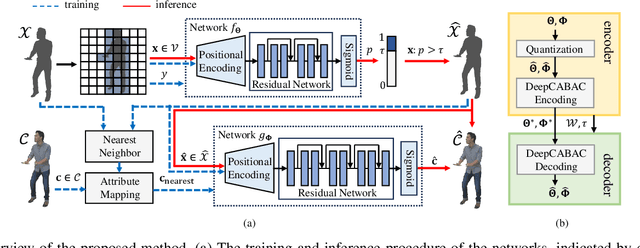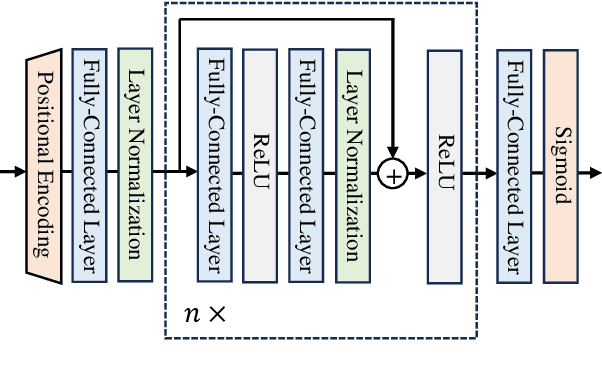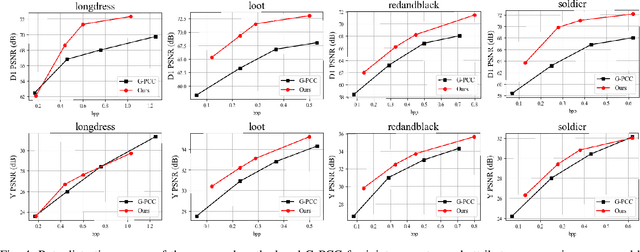Yulin Shao
Towards AI-Native Fronthaul: Neural Compression for NextG Cloud RAN
Jun 07, 2025Abstract:The rapid growth of data traffic and the emerging AI-native wireless architectures in NextG cellular systems place new demands on the fronthaul links of Cloud Radio Access Networks (C-RAN). In this paper, we investigate neural compression techniques for the Common Public Radio Interface (CPRI), aiming to reduce the fronthaul bandwidth while preserving signal quality. We introduce two deep learning-based compression algorithms designed to optimize the transformation of wireless signals into bit sequences for CPRI transmission. The first algorithm utilizes a non-linear transformation coupled with scalar/vector quantization based on a learned codebook. The second algorithm generates a latent vector transformed into a variable-length output bit sequence via arithmetic encoding, guided by the predicted probability distribution of each latent element. Novel techniques such as a shared weight model for storage-limited devices and a successive refinement model for managing multiple CPRI links with varying Quality of Service (QoS) are proposed. Extensive simulation results demonstrate notable Error Vector Magnitude (EVM) gains with improved rate-distortion performance for both algorithms compared to traditional methods. The proposed solutions are robust to variations in channel conditions, modulation formats, and noise levels, highlighting their potential for enabling efficient and scalable fronthaul in NextG AI-native networks as well as aligning with the current 3GPP research directions.
When Feedback Empowers the Uplink: Integrating Adaptive Coding with Wireless Power Transfer
May 28, 2025Abstract:Energy consumption and device lifetime are critical concerns for battery-constrained IoT devices. This paper introduces the Feedback-Aided Coding and Energy Transfer (FACET) framework, which synergistically combines adaptive feedback channel coding with wireless power transfer. FACET leverages the saturation effect of feedback coding, where increasing downlink power yields diminishing returns, to design a dual-purpose feedback mechanism that simultaneously guides uplink coding and replenishes device energy. We characterize the inherent tradeoff between feedback precision and harvested power, and formulate a fairness-constrained min-max optimization problem to minimize worst-case net energy consumption. An efficient algorithm based on alternating optimization and Lagrangian duality is developed, with each subproblem admitting a closed-form solution. Simulations show that FACET nearly triples device lifetime compared to conventional feedback coding architectures, and remains robust across a wide range of power regimes. These results suggest that FACET not only improves communication efficiency but also redefines the role of feedback in energy-constrained IoT systems.
Capacity-Optimized Pre-Equalizer Design for Visible Light Communication Systems
May 26, 2025Abstract:Since commercial LEDs are primarily designed for illumination rather than data transmission, their modulation bandwidth is inherently limited to a few MHz. This becomes a major bottleneck in the implementation of visible light communication (VLC) systems necessiating the design of pre-equalizers. While state-of-the-art equalizer designs primarily focus on the data rate increasing through bandwidth expansion, they often overlook the accompanying degradation in signal-to-noise ratio (SNR). Achieving effective bandwidth extension without introducing excessive SNR penalties remains a significant challenge, since the channel capacity is a non-linear function of both parameters. In this paper, we present a fundamental analysis of how the parameters of the LED and pre-equalization circuits influence the channel capacity in intensity modulation and direct detection (IMDD)-based VLC systems. We derive a closed-form expression for channel capacity model that is an explicitly function of analog pre-equalizer circuit parameters. Building upon the derived capacity expression, we propose a systematic design methodology for analog pre-equalizers that effectively balances bandwidth and SNR, thereby maximizing the overall channel capacity across a wide range of channel attenuations. We present extensive numerical results to validate the effectiveness of the proposed design and demonstrate the improvements over conventional bandwidth-optimized pre-equalizer designs.
Connecting the Unconnectable through Feedback
Jan 04, 2025



Abstract:Reliable uplink connectivity remains a persistent challenge for IoT devices, particularly those at the cell edge, due to their limited transmit power and single-antenna configurations. This paper introduces a novel framework aimed at connecting the unconnectable, leveraging real-time feedback from access points (APs) to enhance uplink coverage without increasing the energy consumption of IoT devices. At the core of this approach are feedback channel codes, which enable IoT devices to dynamically adapt their transmission strategies based on AP decoding feedback, thereby reducing the critical uplink SNR required for successful communication. Analytical models are developed to quantify the coverage probability and the number of connectable APs, providing a comprehensive understanding of the system's performance. Numerical results validate the proposed method, demonstrating substantial improvements in coverage range and connectivity, particularly for devices at the cell edge, with up to a 51% boost in connectable APs. Our approach offers a robust and energy-efficient solution to overcoming uplink coverage limitations, enabling IoT networks to connect devices in challenging environments.
Implicit Neural Compression of Point Clouds
Dec 11, 2024



Abstract:Point clouds have gained prominence in numerous applications due to their ability to accurately depict 3D objects and scenes. However, compressing unstructured, high-precision point cloud data effectively remains a significant challenge. In this paper, we propose NeRC$^{\textbf{3}}$, a novel point cloud compression framework leveraging implicit neural representations to handle both geometry and attributes. Our approach employs two coordinate-based neural networks to implicitly represent a voxelized point cloud: the first determines the occupancy status of a voxel, while the second predicts the attributes of occupied voxels. By feeding voxel coordinates into these networks, the receiver can efficiently reconstructs the original point cloud's geometry and attributes. The neural network parameters are quantized and compressed alongside auxiliary information required for reconstruction. Additionally, we extend our method to dynamic point cloud compression with techniques to reduce temporal redundancy, including a 4D spatial-temporal representation termed 4D-NeRC$^{\textbf{3}}$. Experimental results validate the effectiveness of our approach: for static point clouds, NeRC$^{\textbf{3}}$ outperforms octree-based methods in the latest G-PCC standard. For dynamic point clouds, 4D-NeRC$^{\textbf{3}}$ demonstrates superior geometry compression compared to state-of-the-art G-PCC and V-PCC standards and achieves competitive results for joint geometry and attribute compression.
Integrated Precoder and Trajectory Design for MIMO UAV-Assisted Relay System With Finite-Alphabet Inputs
Nov 13, 2024Abstract:Unmanned aerial vehicles (UAVs) are gaining widespread use in wireless relay systems due to their exceptional flexibility and cost-effectiveness. This paper focuses on the integrated design of UAV trajectories and the precoders at both the transmitter and UAV in a UAV-assisted relay communication system, accounting for transmit power constraints and UAV flight limitations. Unlike previous works that primarily address multiple-input single-output (MISO) systems with Gaussian inputs, we investigate a more realistic scenario involving multiple-input multiple-output (MIMO) systems with finite-alphabet inputs. To tackle the challenging and inherently non-convex problem, we propose an efficient solution algorithm that leverages successive convex approximation and alternating optimization techniques. Simulation results validate the effectiveness of the proposed algorithm, demonstrating its capability to optimize system performance.
Fractional Fourier Domain PAPR Reduction
Nov 13, 2024Abstract:High peak-to-average power ratio (PAPR) has long posed a challenge for multi-carrier systems, impacting amplifier efficiency and overall system performance. This paper introduces dynamic angle fractional Fourier division multiplexing (DA-FrFDM), an innovative multi-carrier system that effectively reduces PAPR for both QAM and Gaussian signals with minimal signaling overhead. DA-FrFDM leverages the fractional Fourier domain to balance PAPR characteristics between the time and frequency domains, achieving significant PAPR reduction while preserving signal quality. Furthermore, DA-FrFDM refines signal processing and enables one-tap equalization in the fractional Fourier domain through the simple multiplication of time-domain signals by a quadratic phase sequence. Our results show that DA-FrFDM not only outperforms existing PAPR reduction techniques but also retains efficient inter-carrier interference (ICI) mitigation capabilities in doubly dispersive channels.
Polarization Aware Movable Antenna
Nov 11, 2024Abstract:This paper presents a polarization-aware movable antenna (PAMA) framework that integrates polarization effects into the design and optimization of movable antennas (MAs). While MAs have proven effective at boosting wireless communication performance, existing studies primarily focus on phase variations caused by different propagation paths and leverage antenna movements to maximize channel gains. This narrow focus limits the full potential of MAs. In this work, we introduce a polarization-aware channel model rooted in electromagnetic theory, unveiling a defining advantage of MAs over other wireless technologies such as precoding: the ability to optimize polarization matching. This new understanding enables PAMA to extend the applicability of MAs beyond radio-frequency, multipath-rich scenarios to higher-frequency bands, such as mmWave, even with a single line-of-sight (LOS) path. Our findings demonstrate that incorporating polarization considerations into MAs significantly enhances efficiency, link reliability, and data throughput, paving the way for more robust and efficient future wireless networks.
Addressing Out-of-Distribution Challenges in Image Semantic Communication Systems with Multi-modal Large Language Models
Jul 22, 2024



Abstract:Semantic communication is a promising technology for next-generation wireless networks. However, the out-of-distribution (OOD) problem, where a pre-trained machine learning (ML) model is applied to unseen tasks that are outside the distribution of its training data, may compromise the integrity of semantic compression. This paper explores the use of multi-modal large language models (MLLMs) to address the OOD issue in image semantic communication. We propose a novel "Plan A - Plan B" framework that leverages the broad knowledge and strong generalization ability of an MLLM to assist a conventional ML model when the latter encounters an OOD input in the semantic encoding process. Furthermore, we propose a Bayesian optimization scheme that reshapes the probability distribution of the MLLM's inference process based on the contextual information of the image. The optimization scheme significantly enhances the MLLM's performance in semantic compression by 1) filtering out irrelevant vocabulary in the original MLLM output; and 2) using contextual similarities between prospective answers of the MLLM and the background information as prior knowledge to modify the MLLM's probability distribution during inference. Further, at the receiver side of the communication system, we put forth a "generate-criticize" framework that utilizes the cooperation of multiple MLLMs to enhance the reliability of image reconstruction.
Point Cloud Compression with Implicit Neural Representations: A Unified Framework
May 19, 2024



Abstract:Point clouds have become increasingly vital across various applications thanks to their ability to realistically depict 3D objects and scenes. Nevertheless, effectively compressing unstructured, high-precision point cloud data remains a significant challenge. In this paper, we present a pioneering point cloud compression framework capable of handling both geometry and attribute components. Unlike traditional approaches and existing learning-based methods, our framework utilizes two coordinate-based neural networks to implicitly represent a voxelized point cloud. The first network generates the occupancy status of a voxel, while the second network determines the attributes of an occupied voxel. To tackle an immense number of voxels within the volumetric space, we partition the space into smaller cubes and focus solely on voxels within non-empty cubes. By feeding the coordinates of these voxels into the respective networks, we reconstruct the geometry and attribute components of the original point cloud. The neural network parameters are further quantized and compressed. Experimental results underscore the superior performance of our proposed method compared to the octree-based approach employed in the latest G-PCC standards. Moreover, our method exhibits high universality when contrasted with existing learning-based techniques.
 Add to Chrome
Add to Chrome Add to Firefox
Add to Firefox Add to Edge
Add to Edge